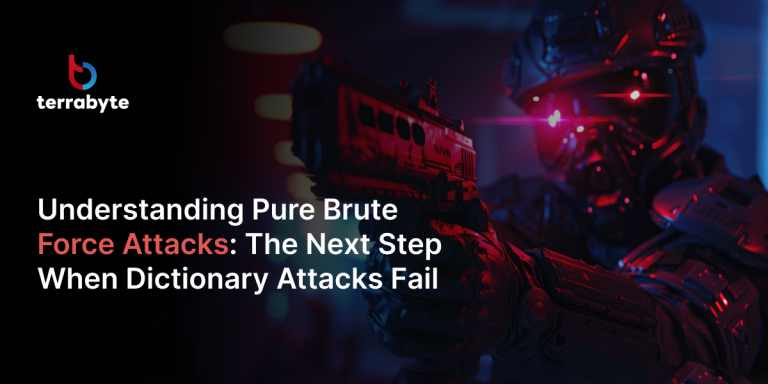In the world of cybersecurity, attackers often use multiple techniques to breach systems. One such method is the **pure brute force attack**, a highly aggressive approach that involves attempting every possible combination of characters to guess a password or unlock an encrypted system. While dictionary attacks—where attackers use lists of common passwords—are often the first line of attack, a pure brute force attack is employed when the dictionary method fails.
Let’s dive into what a pure brute force attack is, why it’s used, and how organizations can defend against this relentless method.
What is a Pure Brute Force Attack?
A pure brute force attack is a hacking method where attackers systematically try every possible combination of characters, numbers, and symbols until the correct password or encryption key is found. Unlike dictionary attacks, which rely on pre-compiled lists of commonly used passwords, brute force attacks leave no stone unturned. They don’t rely on the probability of someone using a weak password; instead, they attempt to crack the password by testing every potential combination, regardless of how complex it may be.
The process can be time-consuming, but with today’s computational power and automated tools, even long and complex passwords can eventually be broken if left unprotected. However, the time and resources required for a pure brute force attack depend heavily on the length and complexity of the password or encryption key being targeted.
How Pure Brute Force Attacks Work
Here’s how a pure brute force attack generally unfolds:
1. Target Identification: As with most cyberattacks, the attacker first identifies a target, typically a login page, encrypted file, or secured system, that they wish to breach.
2. Dictionary Attack Failure: Initially, attackers often try using a dictionary attack—a method that involves trying common passwords from a pre-compiled list. When this method fails, and the system’s password or encryption key is more complex than expected, the attacker escalates the attack to a pure brute force strategy.
3. Automated Tools: Attackers use specialized tools like Hydra, John the Ripper, or Brutus to automate the process of testing every possible character combination. These tools work continuously until they find the correct sequence that unlocks the target.
4. Systematic Testing: The tools begin testing simple character combinations, starting with shorter sequences, and progressively trying longer ones. For instance, they may begin with testing “a,” “b,” “c,” and continue until they reach combinations like “abc123!” or “zYx#45@.”
5. Success Through Exhaustion: If the system’s defenses aren’t strong enough to deter the attack, the brute force method will eventually succeed. It could take minutes, hours, or even years, depending on the strength of the password and the available computational power.
When is a Pure Brute Force Attack Used?
A pure brute force attack is typically a fallback option for attackers. When less resource-intensive techniques—like phishing, social engineering, or dictionary attacks—fail, brute force becomes the next step. This method is usually used in the following scenarios:
1. Highly Secure Targets: If a system or account is secured by a strong, unique password, brute force may be the attacker’s only viable option.
2. Encrypted Files: For encrypted data, where the attacker doesn’t have any other clues or known data, pure brute force might be the only way to break the encryption.
3. When Other Attacks Fail: If simpler, faster methods don’t succeed, an attacker may turn to brute force as a last resort. This method requires a significant investment of time and computing power, making it less attractive initially.
The Challenges of Pure Brute Force Attacks
While pure brute force attacks are effective in theory, they face several challenges in practice:
1. Time and Resources: The time required to brute force a password increases exponentially with each additional character. A short password might take a matter of minutes or hours to crack, but a complex password with 12 or more characters, including symbols, numbers, and both uppercase and lowercase letters, can take years—even with modern computing power.
2. Password Complexity: Strong, complex passwords are more resilient to brute force attacks. For instance, a password like “2j&Lr#0J9vQ!” is far more difficult to break than something like “password123.”
3. Defensive Measures: Many systems implement security measures that lock accounts after a certain number of failed login attempts or introduce delays between each attempt, significantly slowing down brute force attacks.
4. Encryption Strength: Encrypted systems, particularly those using advanced cryptographic algorithms, can be nearly impossible to crack using brute force. Algorithms like AES-256, for example, are designed to withstand even the most determined brute force attempts.
A Real-World Example of a Pure Brute Force Attack
One well-known case of brute force attack success was the hacking of celebrity iCloud accounts in 2014. Although Apple’s systems were relatively secure, attackers were able to use a brute force attack to guess weak passwords. The attack leveraged flaws in the system’s password reset and login mechanisms, allowing attackers to try unlimited combinations until they accessed private data.
Defending Against Pure Brute Force Attacks
The good news is that there are effective ways to defend against brute force attacks:
1. Use Strong, Unique Passwords: The longer and more complex a password, the harder it is to crack. A strong password should be at least 12 characters long and include a mix of uppercase letters, lowercase letters, numbers, and special symbols.
2. Multi-Factor Authentication (MFA): MFA adds an extra layer of security by requiring a second form of verification, such as a text message code or biometric authentication. Even if an attacker guesses a password, they still need to bypass this additional step.
3. Account Lockout Mechanisms: Systems should lock accounts after a certain number of failed login attempts. This makes brute force attacks far less feasible, as the attacker is blocked from continuing their guesses.
4. Password Hashing: Properly hashing and salting stored passwords can significantly increase the difficulty of cracking them with brute force attacks.
5. Rate Limiting and Delays: Introducing delays between login attempts or limiting the number of attempts can slow down a brute force attack to the point where it becomes impractical.
Conclusion
A pure brute force attack is a brute-force method to crack passwords or encryption keys by testing all possible combinations of characters. While time-consuming and resource-intensive, this technique can eventually succeed if a system is poorly secured. However, by implementing strong passwords, multi-factor authentication, and other security measures, organizations can defend against these relentless attacks. In an era where cybersecurity threats continue to evolve, being proactive in fortifying defenses against brute force is essential.





